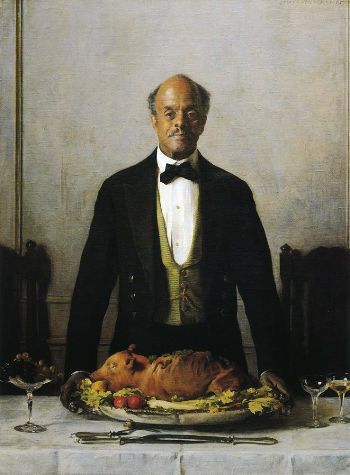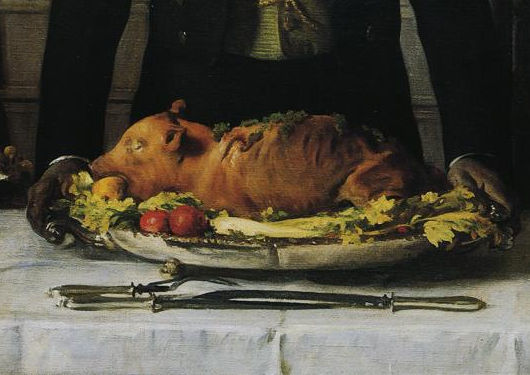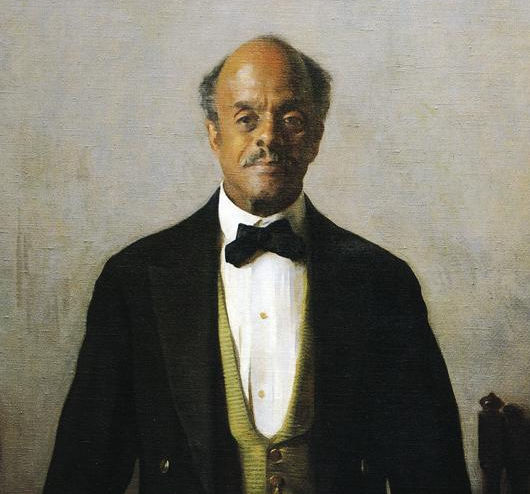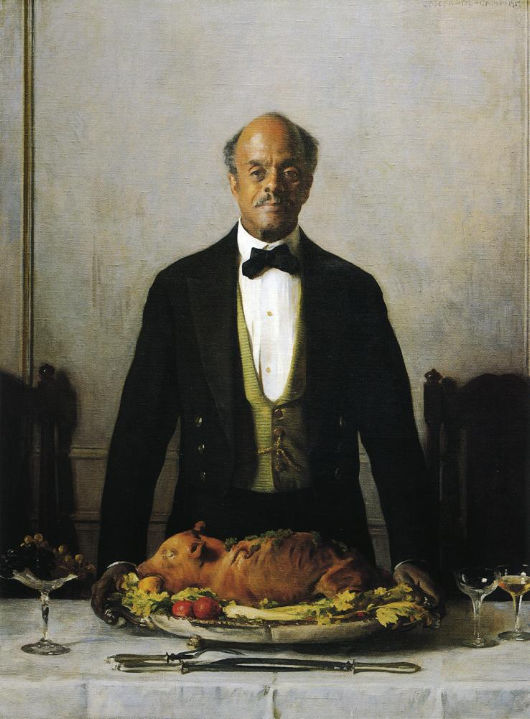
About Andrew Cusack
 Writer, web designer, etc.; born in New York; educated in Argentina, Scotland, and South Africa; now based in London.
Writer, web designer, etc.; born in New York; educated in Argentina, Scotland, and South Africa; now based in London. read more
News
Blogs
Reviews & Periodicals
Arts & Design
World
France
Mitteleuropa
Knickerbockers
Argentina
The Levant
Africa
Cape of Good Hope
Netherlands
Scandinavia
Québec
India
Muscovy
Germany
Academica
Lewis of the Porcellian

Oil on canvas, 54 in. x 40 in.
1919, the Porcellian Club
The Porcellian Club at Harvard University was founded in 1791 and McKean Gate, the entrance to Harvard Yard opposite the club’s quarters on Massachusetts Avenue in Cambridge, features a boar’s head in tribute. Digby Baltzell ranked the Porc (as it is colloquially known) as the most exclusive of Harvard’s “final clubs”, and Porcellian is known for having correctly turned its nose to Harvard seniors who later turned out to be no good: Joseph Kennedy was blackballed and Franklin D. Roosevelt described his failure to be elected to Porcellian as “the greatest disappointment of my life”.
Among the names who did make the cut are Senator Henry Cabot Lodge, President Theodore Roosevelt, architect H.H. Richardson, Hamilton Fish III & Hamilton Fish IV (I & II were, appropriately, Columbia men), the poet Oliver Wendell Holmes Sr., his son the Supreme Court justice Oliver Wendell Holmes Jr., and plenty of good old bearers of the sacred surnames of Boston (Adams, Cabot, Phillips …). The late George Plimpton — founder of the Paris Review and Fireworks Commissioner of New York City — was a member of Porcellian (in addition to the Hasty Pudding Club).

And yet, to what end does the Porcellian exist? Jeffrey Hart — Dartmouth professor, National Review editor, and frequent contributor to The New Criterion — describes it “an undergraduate club of extraordinary exclusiveness”:
My favorite story about Porcellian, even though it’s pure myth, is that if a member hadn’t made his first million by 40, the others members would just give it to him.

This portrait, however, is not of any famous club member but of George Washington Lewis — “Lewis of the Porcellian” — the club’s steward. Elliot Perkins, the great-grandson of John Quincy Adams, was elected to Porcellian during his time at Harvard and, assuming that Lewis’s family came from the South like most Northern blacks, asked “Mr. Lewis, when did your people come up North?” The porter responded “Mr. Perkins, my great-grandfather fought in the Battle of Bennington, which is in Vermont, as you may know.”
Lewis’s visage is almost expressionless in its seriousness, but one can still discern the remnants of a certain pride about his face. Lewis, no doubt, took great pride in his vocation, and his service was amply appreciated by his charges. When he died in 1929, having served the club for forty-five years, George Washington Lewis had ten Porcellian members as his pallbearers. That, even more than this fine portrait, is a fitting tribute to a life of service.

Search
Instagram: @andcusack
Click here for my Instagram photos.Most Recent Posts
- Gellner’s Prague December 19, 2024
- Monsieur Bayrou December 18, 2024
- Dempsey Heiner, Art Critic December 17, 2024
- Vote AR December 16, 2024
- Articles of Note: 12 December 2024 December 12, 2024
Most Recent Comments
Book Wishlist
Monthly Archives
Categories



Joseph DeCamp is one of my favorite painters. Have you seen “The Blue Cup” at the Museum of Fine Arts, Boston?
Another article of elegance and real value Cusack; well done.
The world is so very small: two of my cousins, Harvard men, Alexander White Moffat and his brother Donald, born in Brooklyn and grandsons of Seth Low, each married a daughter of Joseph DeCamp. Both were so enchanted by their Harvard experience that they stayed on in Massachusetts for the rest of their lives; Donald actually contributing a preface (he was a writer) to a book of photographs called “Fair Harvard”.
But were they Porcellians? That I can’t say. They were painted by their father-in-law though, and that will probably prove a more lasting distinction.
George Washington Lewis appears to resemble Jeeves, in his speech no less than in his appearance. How splendid.
Splendid, also, about Bootlegger Joe Kennedy and FDR getting snubbed. There is justice in the world after all.
Bonne chance avec votre séjour québecois, Monsieur Cusack.
Hmm, Assumption College could use a club for club’s sake too; if only we had a few more elites.
So Joe Kennedy and FDR both failed to make it into Porcellian (though I believe FDR made it to Fly–a club of equal stature). This makes one ask: so who were these worthies who DID make it to the little pig? Offhand I can think of Hamilton Fish and Theodore Roosevelt. Any bigger or more contemporary names?
I mention both those names, and more, in the second paragraph.
The answer must be: clubability combined with appropriate social standing.
Take the following members of the New York social elite:
Louis Crawford Clark, his brother David Crawford Clark; his sons Louis Crawford Clark Jr, Grenville Clark, Henry Cannon Clark, Julian Bouton Clark; his nephews George Crawford Clark, James Averell Clark (whose son married a daughter of the Earl of Minto), Crawford Blagden, Arthur Campbell Blagden, Francis Meredith Blagden, and his nephew-in-law Reginald Fincke (whose daughter married the Earl of Perth); all were Porcellians. Only one went on to fame (they all had fortune already). Their common bond was wealth, family ties, social standing, and that undefinable something which made them enjoyable to be around. Nothing else was required. They were chosen, not to get on, but because they knew how to get along. It is as simple as that.
great to see my fathers name above[JAC]I will becoming interested in reading further!
Am writing a memoir for Joseph DeCamp’s descendents…my children, in particular who are his great great grandchildren. Any personal information would be appreciated. Thanks, Sherry
Hello there.
10 years after the date of this publishing …is there any chAnce to have a contact ? Indeed I am a great great grandchildren òf Joseph R. DeCamp and my grandfather was Donald Moffat. My father François Giraud was in the M.I.T and married Pauline (Babes) Moffat . But they lived in France where we (7 children – 1 boy and 6 girls) are all born ! I am very pleased with this historical aspect of the Porcellian painting and the comments of Peter ☺ and Sherry Miller Welch . In France , I never heard someone mentioning DeCamp , but I have a book about him – life and paintings . Merci beaucoup pour votre site Andrew Cusack?